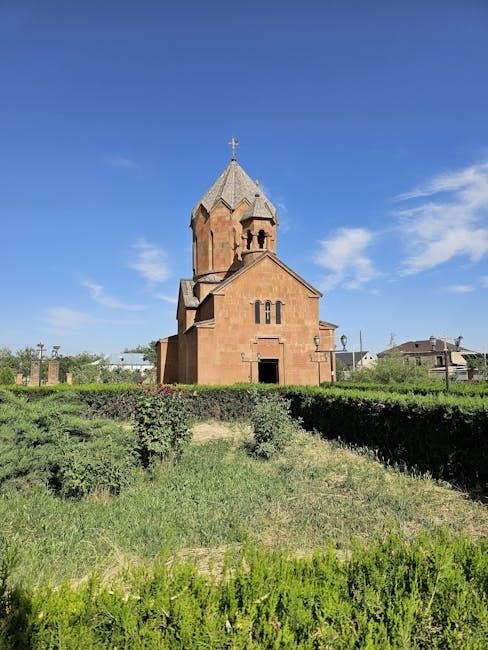The Stations of the Cross are a traditional Lenten devotion, offering a powerful way to contemplate Christ’s passion and death through prayer and meditation. Each station represents a pivotal moment in His journey to Calvary, providing a visual and spiritual tool to deepen faith and reflection.
Overview of the Stations of the Cross
The Stations of the Cross are a series of 14 devotional reflections that trace Jesus Christ’s journey from condemnation to burial. Each station symbolizes a specific event in His Passion, offering a profound way to engage with the Savior’s sacrifice. Traditionally displayed in churches as images or icons, the stations guide believers through moments of sorrow and redemption. Modern adaptations, such as downloadable PDFs, make this practice accessible for personal or communal use. These resources often include Scripture readings, prayers, and meditations tailored to each station, fostering a deeper spiritual connection. The Stations of the Cross serve as a powerful tool for reflection, inviting the faithful to walk alongside Jesus, contemplating His love and mercy. This practice is particularly meaningful during Lent, helping believers prepare for Easter by embracing the depths of Christ’s love. The stations remain a timeless and universal devotion, enriching the spiritual lives of millions worldwide.

Significance of the 14 Stations in Christian Devotion

The 14 Stations of the Cross hold profound spiritual significance in Christian devotion, serving as a poignant reminder of Christ’s sacrificial love and redemption. This ancient practice invites believers to reflect on Jesus’ Passion, fostering empathy and gratitude for His suffering. By meditating on each station, the faithful connect with the emotional and spiritual depths of His journey, deepening their relationship with Him. The stations also emphasize the universal call to carry one’s cross, aligning with Christ’s teachings on self-denial and love. During Lent, this devotion becomes particularly meaningful, helping Christians prepare for Easter by contemplating the mystery of salvation. The availability of Stations of the Cross in PDF formats has made this timeless practice more accessible, allowing individuals and communities to engage with it privately or collectively, enriching their spiritual lives.

History and Origins of the Stations of the Cross
The Stations of the Cross trace their origins to early Christian pilgrims following the Via Dolorosa in Jerusalem. This devotion spread to Europe and evolved into the 14-station format by the 18th century, now widely used in PDF guides for prayer and reflection.
Development of the Tradition
The tradition of the Stations of the Cross began with early Christian pilgrims retracing Jesus’ journey to Calvary in Jerusalem. Over centuries, this practice evolved, influenced by the Crusades and Franciscan friars who promoted the devotion in Europe. Initially, the number of stations varied, but by the 18th century, the 14-station format became standardized. The Stations were often depicted in art within churches, serving as visual aids for meditation. Today, the tradition is enhanced by digital resources, such as PDF guides, which include prayers, scriptures, and reflections. These tools make the devotion accessible for personal or communal use, ensuring the tradition remains vibrant and relevant for modern Christians seeking to deepen their faith during Lent.

Evolution of the 14 Stations Over Time
The Stations of the Cross have undergone significant evolution since their inception. Originating from early Christian pilgrims visiting Jerusalem, the practice spread globally, adapting to cultural and liturgical changes. Initially, the number of stations varied, but by the 18th century, the 14-station format became universal. The tradition was further enriched by the Franciscans, who formalized the prayers and meditations associated with each station. Modern technology has expanded its reach, with digital resources like PDF guides offering accessible ways to engage with the devotion. These resources often include scriptures, prayers, and reflections, making the Stations of the Cross a dynamic and enduring spiritual practice for Christians worldwide.

The 14 Stations Explained
The 14 Stations of the Cross represent key events in Jesus’ journey to Calvary, offering a profound devotional practice for reflection and prayer during Lent.
First Station: Jesus is Condemned to Death
JESUS IS CONDEMNED TO DEATH. Pilate condemns Jesus to die. Priest: We adore You, O Christ, and we praise You. People: Because by Your holy cross You have redeemed the world.

Second Station: Jesus Accepts His Cross
At the second station, Jesus accepts His cross, embodying humility and obedience. Pilate, unable to find fault in Him, sentences Him to death by crucifixion. Jesus, with unwavering resolve, takes up the cross, bearing the weight of humanity’s sins. This act symbolizes His willingness to endure suffering for the redemption of the world. Reflecting on this station, we are invited to contemplate our own willingness to carry life’s burdens and to follow Christ’s example of selfless love. The cross becomes a powerful symbol of sacrifice and devotion, urging us to embrace our own crosses with faith and courage. Through this station, we deepen our understanding of Christ’s love and commitment to our salvation.
Third Station: Jesus Falls the First Time
The third station depicts Jesus falling under the weight of the cross for the first time. This moment highlights His physical and emotional suffering, as well as His vulnerability. The crowd watches as He stumbles, a vivid reminder of His humanity. Despite the pain, Jesus perseveres, demonstrating His unwavering commitment to His mission. This station invites us to reflect on our own struggles and how we respond to life’s challenges. By identifying with Christ’s fall, we are reminded that even in weakness, there is strength and grace. The fallen Jesus calls us to embrace our own crosses with courage and trust in God’s plan. This station deepens our empathy for Christ’s sacrifices and encourages us to seek resilience in our faith journey.
Fourteenth Station: Jesus is Laid in the Tomb
The Fourteenth Station marks the final moment of Christ’s Passion, as His lifeless body is placed in the tomb. This station invites us to reflect on the stillness and sorrow of this moment, as well as the hope it embodies. Nicodemus and Joseph of Arimathea, with reverence and care, wrap Jesus’ body in linen cloths and lay Him in a sepulcher. The tomb, a place of rest, becomes a symbol of transition, as Christ’s death gives way to the promise of resurrection. This station encourages us to contemplate the mystery of life, death, and eternal life, and to trust in God’s plan even in the face of darkness. It reminds us that Christ’s sacrifice was not in vain, as the tomb would soon become a womb of new life, forever changing humanity’s destiny. This moment calls us to surrender, hope, and faith in the power of God.

Using the 14 Stations of the Cross PDF
The 14 Stations of the Cross PDF offers a convenient way to engage in this devotion. It can be downloaded and printed, featuring prayers, reflections, and scripture readings for each station, making it an accessible tool for personal or communal meditation. The PDF serves as a guide to deepen one’s faith and connection with Christ’s Passion.
Downloading and Printing the PDF
Downloading and printing the 14 Stations of the Cross PDF is a straightforward process. Many Catholic churches and religious websites offer free PDF versions of the Stations of the Cross, which can be easily accessed online. These PDFs often include prayers, reflections, and scripture readings for each station, along with images or illustrations to enhance meditation. To download, simply visit a reliable source, such as a church website or a trusted religious portal, and follow the provided links. Once downloaded, the PDF can be printed on standard paper, ensuring the text and images are clear. Some versions are designed for personal devotion, while others are formatted for group use. Printing the PDF allows individuals to carry the Stations with them, making it a convenient tool for prayer and reflection during Lent or any time of the year. Additionally, some PDFs include optional covers or staples for binding, creating a neat and portable booklet.
Guided Prayers and Meditations

Using the 14 Stations of the Cross PDF, individuals can engage in meaningful prayer and meditation. Each station is accompanied by specific prayers, reflections, and scripture readings, guiding devotees through Christ’s journey to Calvary. The PDF often includes a leader’s part, followed by congregational responses, creating a structured format for worship. For example, the Second Station begins with, “We adore You, O Christ, and we praise You,” followed by reflections on Jesus accepting His cross. Similarly, the Seventh Station focuses on His second fall, emphasizing the physical and emotional toll of His sacrifice. These guided prayers help participants connect deeply with the Passion of Christ, fostering a spirit of repentance and gratitude. The meditations encourage introspection, allowing individuals to align their lives with the teachings of Jesus. This structured approach makes the Stations of the Cross accessible for both personal and communal devotion, especially during Lent.
The 14 Stations of the Cross PDF serves as a profound and accessible resource for Christians seeking to deepen their spiritual journey, particularly during Lent. By guiding users through the pivotal moments of Christ’s passion, from His condemnation to His burial, the Stations offer a meaningful way to reflect on His sacrifice and resurrection. The accompanying prayers and meditations provide a structured framework for worship, allowing individuals to connect emotionally and spiritually with the narrative of redemption. Whether used for personal devotion or communal prayer, the Stations of the Cross PDF remains a timeless and universal tool for fostering faith and gratitude. It invites believers to walk alongside Jesus, embracing the transformative power of His love and sacrifice, and to find renewal in the promise of Easter.



